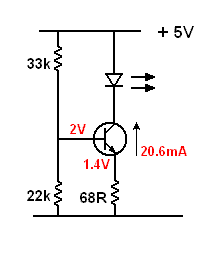kdg007
Full Member level 3

Hi ,
I am pretty new to electronics. I am trying to build a basic circuit with 2N2222 transistor.
5VDC supply(+ve) to base and collector pins.
R1 -390 ohms to base,
R2-45ohms and LED(white) connected to the collector side,
R3= 1k ohms connected to the base and emitter and ground.
5VDC (-ve) ground.
when i switched on the battery (5volts)... the LED is not switched on .. according to my calculations,77ma of current must go through the LED.
base current = 10.02ma,collector current = 77.12ma.
-
where did i went wrong ?? any suggestions are welcome
thanks in advance !!!!
I am pretty new to electronics. I am trying to build a basic circuit with 2N2222 transistor.
5VDC supply(+ve) to base and collector pins.
R1 -390 ohms to base,
R2-45ohms and LED(white) connected to the collector side,
R3= 1k ohms connected to the base and emitter and ground.
5VDC (-ve) ground.
when i switched on the battery (5volts)... the LED is not switched on .. according to my calculations,77ma of current must go through the LED.
base current = 10.02ma,collector current = 77.12ma.
-
where did i went wrong ?? any suggestions are welcome
thanks in advance !!!!



